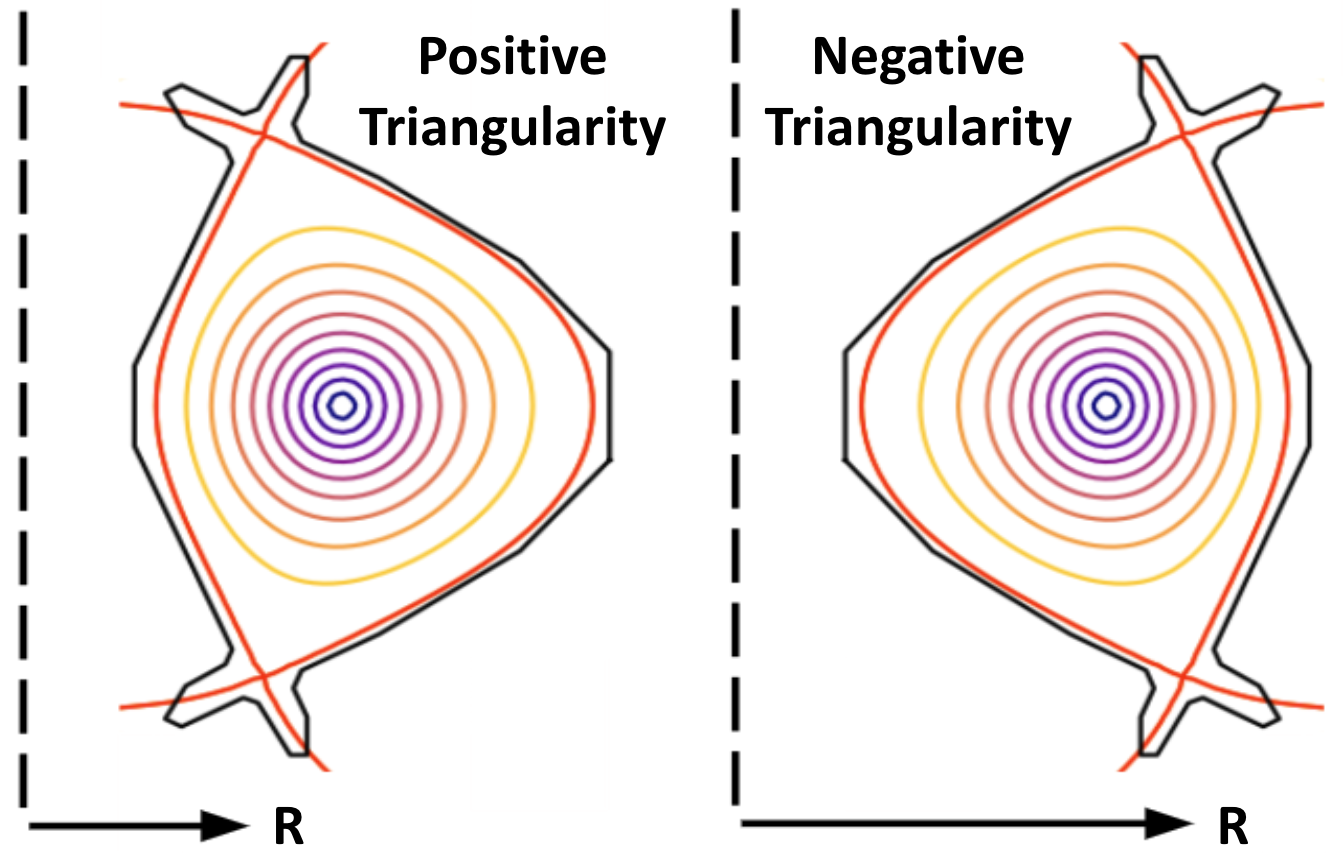The pursuit of commercial fusion energy, which could provide a clean and effectively limitless power source for humanity, is often heralded as one of the most important and difficult scientific endeavors of our time. One of the leading approaches for fusion, the tokamak, uses magnetic fields to confine a hot and dense plasma inside a toroidal vacuum vessel. Typically, this configuration can access plasma conditions capable of sustained fusion reactions, but in the process of doing so creates periodic edge instabilities called “ELMs” (Edge Localized Modes) that release tremendous heat fluxes onto the machine walls. Avoidance of ELMs is essential to power plant operation, but existing techniques to do so are often extremely sensitive to plasma conditions and come with a measurable decrease in plasma performance.
Enter negative triangularity (NT).
By changing the shape of the plasma cross-section, NT scenarios provide a simple and robust solution to the power-handling problem in tokamaks by eliminating the triggering of ELMs via regulation of the edge pressure gradient with high-n ballooning modes. On the DIII-D and TCV tokamak facilities, NT ELM suppression is found to be fully compatible both with high core performance (simultaneous access to high normalized confinement, normalized pressures, and Greenwald fractions) and with divertor detachment. Since the NT ELM suppression effect is linked directly to geometry-induced changes in the magnetic shear, NT fusion pilot plants are predicted to maintain advantageous ELM-free edge conditions even in burning plasma regimes. Further, the natural tendency for NT plasmas to avoid H-mode even at high heating power could simplify impurity regulation and auxiliary power control in a reactor setting, and the NT geometry could facilitate larger divertor surfaces for exhaust mitigation. Together, these characteristics suggest that negative triangularity may be able to provide something that no other tokamak scenario can: a robust path to an inherently ELM-free fusion pilot plant.
 A cartoon comparing negative and positive triangularity tokamak operation. The center axis is shown as a dashed line.
A cartoon comparing negative and positive triangularity tokamak operation. The center axis is shown as a dashed line.
A main thrust of my work is to explore how NT configurations can help to establish robust and reliable fusion power plant designs. In collaboration with students at Columbia and MIT, I helped design a novel tokamak concept called MANTA “Modular, Adjustable, Negative-Triangularity ARC,” which uses the advantages of NT to achieve burning plasma regimes while maintaining compatibility with conservative engineering constraints. There is still much work to be done on fleshing out and solidifying this design space, which must find self-consistent scenarios describing everything from the core plasma physics to the electrical grid connection.
Selected publications on this subject:
MANTA: A Negative-Triangularity NASEM-compliant fusion pilot plant
The MANTA Collaboration, Rutherford, G., Wilson, Haley S., Saltzman, A., and Arnold, D., Ball, J., Benjamin, S., Bielajew, R., De Boucaud, N., Calvo Carrera, M., Chandra, R., Choudhury, H., Cummings, C., Corsaro, L., DaSilva, Nigel., Diab, R., Devitre, A., Ferry, S., Frank, S., Hansen, C., Jerkins, J., Johnson, J., Lunia, P., Van De Lindt, J., Mackie, S., Maris, A., Mandell, N., Miller, M., and Mouratidis, T., Nelson, A. O., Pharr, M., Peterson, E., Rodriguez-Fernandez, P., Segatin, S., Tobin, M., Velberg, A., Wang, A., Wigram, M., Witham, J., Paz-Soldan, C. & Whyte, D., Plasma Physics and Controlled Fusion 66, 105006 (2024).
Power handling in a highly-radiative negative triangularity pilot plant
Miller, M. A., Arnold, D., Wigram, M., Nelson, A. O., Witham, J., Rutherford, G., Choudhury, H., Cummings, C., Paz-Soldan, C. & Whyte, D. G.,. Plasma Physics and Controlled Fusion 66, 125004 (2024).
Characterizing the negative triangularity reactor core operating space with integrated modeling
Wilson, H., Nelson, A. O., McClenaghan, J., Rodriguez Fernandez, P., Parisi, J. & Paz-Soldan, C., Plasma Physics and Controlled Fusion, in review (2024).
Exploring the Negative-Triangularity Pathway to Fusion with MANTA
Nelson, A. O., et al., 29th IAEA Fusion Energy Conference (October 2023).
Prospects for H-mode inhibition in negative triangularity tokamak reactor plasmas
Nelson, A. O., Paz-Soldan, C. & Saarelma, S., Nuclear Fusion 62, 096020 (2022).